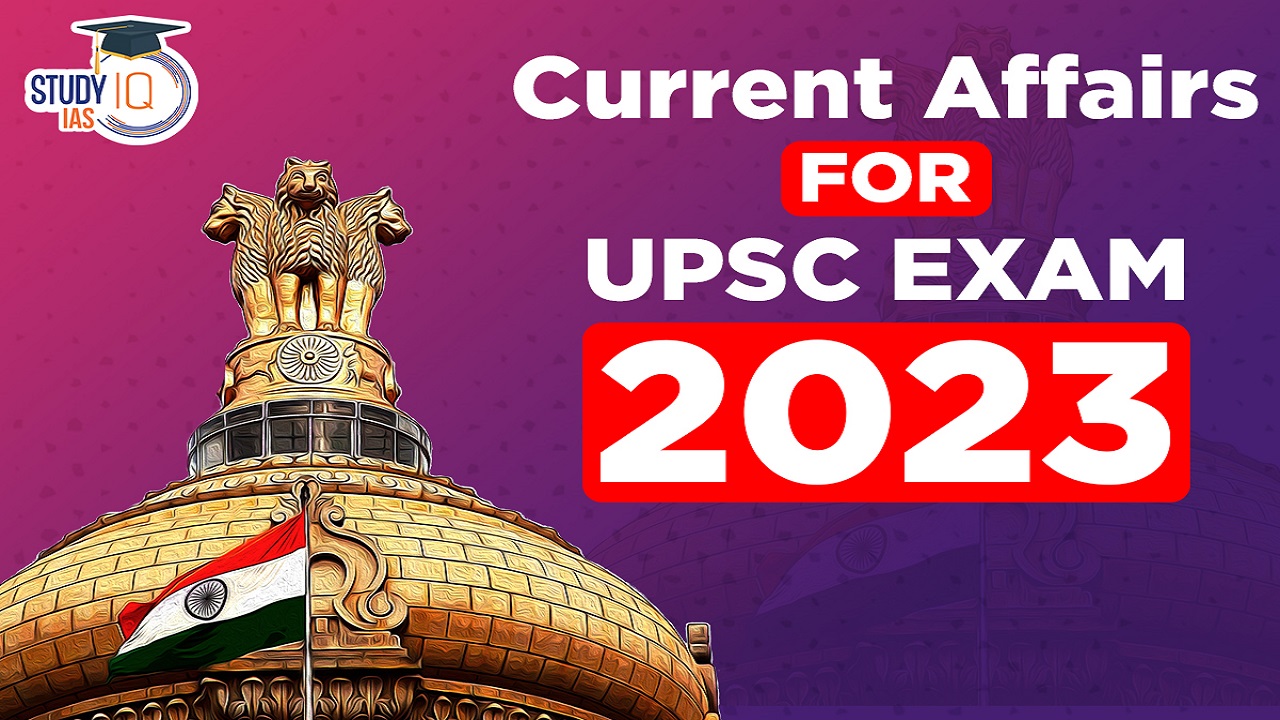Current Affairs 4th July 2023 for UPSC Prelims Exam
Gallantry Awards
Context: Rifleman Jaswant Singh was awarded the second highest gallantry award, Maha Vir Chakra, for his role in 1962 Sino-Indian war.
What are Gallantry Awards?
- Definition: The Gallantry awards in India are announced twice in a year:
- First on the Republic Day
- On the Independence Day.
- Order of Precedence of these Awards: Param Vir Chakra, Ashoka Chakra, Mahavir Chakra, Kirti Chakra, Vir Chakra and Shaurya Chakra.
- History: Post-independence, first three gallantry awards namely Param Vir Chakra, Maha Vir Chakra and Vir Chakra were instituted by the Government of India on 26th January 1950 which were deemed to have effect from the 15th August, 1947.
- Thereafter, other three gallantry awards i.e., Ashoka Chakra Class-I, Ashoka Chakra Class-II and Ashoka Chakra Class-III were instituted by the Government of India on 4th January 1952, which were deemed to have effect from the 15th August, 1947.
- These awards were renamed as Ashoka Chakra, Kirti Chakra and Shaurya Chakra respectively in January 1967.
- Investiture Ceremony: Gallantry awards are conferred to the awardees/Next-of-Kins (NoKs) by the President at the Defence Investiture Ceremony held every year at the Rashtrapati Bhawan.
- However, the Param Vir Chakra and the Ashoka Chakra are conferred by the President to the awardees/NoKs on the Republic Day Parade at the Rajpath.
Gallantry Awards
- Param Vir Chakra: Circular in shape, made of bronze, one and three eighth inches in diameter.
- On obverse, four replicas of “Indra’s Vajra” with the State Emblem embossed in the centre.
- On its reverse, it has embossed Param Vir Chakra both in Hindi and English with two lotus flowers between Hindi and English.
- Eligibility: Officers of the Army, the Navy and the Air Force, of any of the Reserve Forces, of the Territorial Army.
- Nursing and Civilians serving regularly or temporarily under above-mentioned Forces.
- Conditions of Eligibility: The Chakra is awarded for most conspicuous bravery or some daring or pre-eminent act of valour or self-sacrifice, in the presence of the enemy, whether on land, at sea, or in the air.

- Ashoka Chakra: Circular in shape, one and three eighth inches in diameter with rims on both sides and will be of gold-gilt.
- On the obverse, it has embossed a replica of Ashoka’s Chakra in the centre surrounded by a lotus wreath.
- On it has embossed the words “Ashoka Chakra” both in Hindi and English, the two versions being separated by two lotus flowers.
-
- Eligibility: Officers of the Army, the Navy and the Air Force, of any of the Reserve Forces, of the Territorial Army.
- Members of the Nursing Services of the Armed Forces.
- Civilian citizens and members of Police Forces including Central Para-Military Forces and Railway Protection Force.
- Conditions of Eligibility: The Chakra is awarded for most conspicuous bravery or some act of daring or pre-eminent act of valour or self-sacrifice otherwise than in the face of the enemy.
- Eligibility: Officers of the Army, the Navy and the Air Force, of any of the Reserve Forces, of the Territorial Army.

- Mahavir Chakra: Circular in shape and is made of standard silver and is embossed on the obverse a five-pointed heraldic star with the points of the star just touching the rim.
- The State emblem is embossed in the centrepiece.
- The star is polished and the centre piece is in gold gilt.
- On the reverse it has embossed Maha Vir Chakra both in Hindi and English with two lotus flowers between Hindi and English.
- Eligibility: Officers of the Army, the Navy and the Air Force, of any of the Reserve Forces, of the Territorial Army.
- Nursing and Civilians serving regularly or temporarily under above-mentioned Forces.
- Conditions of Eligibility: The medal is awarded for gallantry in the presence of the enemy on land, at sea or in the air.

- Kirti Chakra: Circular in shape and is made of standard silver, one and three eight inches in diameter.
- On the obverse of the medal has embossed a replica of Ashoka Chakra in the centre, surrounded by a lotus wreath.
- On its reverse shall be embossed the words KIRTI CHAKRA both in Hindi and in English the versions being separated by two lotus flowers.
- Eligibility: Officers of the Army, the Navy and the Air Force, of any of the Reserve Forces, of the Territorial Army.
- Members of the Nursing Services of the Armed Forces.
- Civilian citizens and members of Police Forces including Central Para-Military Forces and Railway Protection Force.
- Conditions of Eligibility: The medal is awarded for conspicuous gallantry otherwise than in the face of the enemy.

- Vir Chakra: Circular in shape and is made of standard silver and is embossed on the obverse a five-pointed heraldic star with the points of the star just touching the rim.
- The State Emblem (including motto) is embossed in the centrepiece which is domed.
- The star is polished, and the centre piece is in gold gilt.
- On the reverse it has embossed Vir Chakra both in Hindi and English with two lotus flowers between Hindi and English wording.
- Eligibility: Officers of the Army, the Navy and the Air Force, of any of the Reserve Forces, of the Territorial Army.
- Nursing and Civilians serving regularly or temporarily under above-mentioned Forces.
- Conditions of Eligibility: The Chakra is awarded for acts of gallantry in the presence of the enemy, whether on land or at sea or in the air.

- Shaurya Chakra: Circular in shape and of bronze, one and three-eighth inches in diameter.
- On the obverse of the medal shall have embossed a replica of Ashoka Chakra in the centre, surrounded by a lotus wreath.
- On its reverse it has embossed the words “SHAURYA CHAKRA” both in Hindi and English, the two versions being separated by two lotus flowers.
- Eligibility: Officers of the Army, the Navy and the Air Force, of any of the Reserve Forces, of the Territorial Army.
- Members of the Nursing Services of the Armed Forces.
- Civilian citizens and members of Police Forces including Central Para-Military Forces and Railway Protection Force.
- Conditions of Eligibility: The Chakra is awarded for gallantry otherwise than in the face of the enemy.

Current Affairs 3rd July 2023 for UPSC Prelims Exam
Pangong Lake
Context: Three years after the violent clash between Indian and Chinese forces in Galwan valley, there has been increased infrastructural activity in the area around the Pangong Tso.
More on the news
- On one side, China has ramped up activities to complete a bridge across the Pangong Tso, which will connect the north and south banks.
- On the other hand, India is constructing a road on its side on the north bank.
- Development of infrastructure has been increased from both sides.
About the Pangong Lake
- Location: It is an endorheic lake spanning eastern Ladakh and West Tibet situated at an elevation of 4,225 m (13,862 ft).
- An endorheic lake is a type of lake that does not have an outlet or a visible outflow of water.
- Formation: Pangong Tso Lake is formed from the Tethys geosyncline.
- The Tethys geosyncline, also referred to as the Tethys Sea or Tethys Ocean, was a vast ancient oceanic basin that existed during the Paleozoic and Mesozoic eras.
- The Tethys geosyncline underwent subduction, giving rise to significant mountain systems such as the Alps, the Himalayas, and the Zagros Mountains.
- Sub lakes: Pangong Lake is 134 km long and divided into five sublakes, called Pangong Tso, Tso Nyak, Rum Tso (twin lakes) and Nyak Tso.
- Approximately 50% of the length of the overall lake lies within Tibet in China, 40% in Ladakh, India and the remaining 10% is disputed and is a de facto buffer zone between India and China.
- Key features:
- The Karakoram Mountain range ends at the north bank of Pangong Tso.
- Its southern bank too has high broken mountains sloping towards Spangur Lake in the south.
- During winter the lake freezes completely, despite being saline water.
- It has a land-locked basin separated from the Indus River basin by a small, elevated ridge.
- Biodiversity:
- Low biodiversity has been reported here due to high salinity and harsh environmental conditions.
- It’s an important breeding ground for migratory birds such as the Bar-headed goose and Brahmini ducks.

Sickle Cell Disease
Context: “Sickle Cell Anaemia Elimination Mission 2047” has been launched by the PM of India for eradicating the sickle cell disease.
What is Sickle Cell Disease (SCD)?
- Definition: Sickle cell disease is a group of inherited red blood cell disorders that affect hemoglobin, the protein that carries oxygen through the body.
- Normally, red blood cells are disc-shaped and flexible enough to move easily through the blood vessels.
- In the sickle cell disease, the red blood cells are crescent- or “sickle”-shaped. These cells do not bend or move easily and can block blood flow to the rest of the body.

- Types: Sickle cell disease exists in two forms within the human body.
- One is the Sickle Cell trait, in which the individual does not exhibit any disease or symptoms and lives a normal life.
- The second form is characterized by the presence of symptoms related to sickle cell disease.
- Symptoms: Swelling of hands and feet, Anemia, Periodic episodes of extreme pain, infections, vision problems, significant reduction in life expectancy.
- Spread: If two individuals with Sickle Cell trait marry each other, there is a high probability that their child will have Sickle Cell disease.
- Cure: SCD can only be cured by bone marrow or stem cell transplantation.
- These transplants are normally reserved for children with severe SCD since they are hazardous and can have substantial adverse effects.
Sickle Cell Disease in India
- Affected Population: In India, there are approximately 706 different tribal communities, which constitute 8.6% of the total population. Sickle cell disease is a serious health challenge in India’s tribal population.
- Prevalence of SCD in States:
- High Prevalence: Rajasthan, Gujarat, Madhya Pradesh, Chhattisgarh, Jharkhand, West Bengal, Odisha, Telangana, Andhra Pradesh, Tamil Nadu, Kerala, Karnataka, and Maharashtra.
- Partial Prevalence: Bihar, Assam, Uttarakhand, and Uttar Pradesh.
- Prevention Approach by GoI: The first approach focuses on prevention, ensuring that new cases are not born, while the second approach involves managing the treatment and providing adequate healthcare facilities for individuals already affected by the disease.
- National Sickle Cell Anaemia Elimination Mission:
- Aim: The Mission aims to address the pressing health challenges posed by sickle cell disease, particularly among the tribal population.
- It shall eliminate sickle cell disease as a public health problem by 2047.
- The program is executed in a mission mode as part of the National Health Mission (NHM).
- Objectives:
- Provision of affordable and accessible care to all SCD patients.
- To ensure quality of care for SCD patients.
- To reduce the prevalence of SCD.
- Implementation:
- Screening of Individuals: By screening individuals for Sickle Cell trait before marriage, the spread of the disease can be prevented.
- The Ministry of Health, in collaboration with the Ministry of Tribal Affairs and the states, has formulated a plan to screen approximately 70 million individuals aged 0-40 years belonging to tribal groups residing in 17 states.
- Issue of Smart Cards: After screening, individuals will be provided with smart cards in their local language, enabling prospective partners to easily determine whether their future children will be affected by Sickle Cell disease or not.
- Monitoring: To implement this entire programme, monitoring mechanisms will be established at various levels to ensure participation and bring awareness on a large scale.
- Testing: Individuals identified with the disease through screening will undergo regular testing, receive treatment and medication, vaccinations for other diseases, get dietary support, and have access to timely counselling services.
- Budget, Training & Technology: The government has allocated a sufficient budget, utilised advanced technology and ensured necessary infrastructure to combat this disease.
- Training of Workers: Through the Ayushman Bharat scheme, India has established a network of 1.6 lakh Health and Wellness Centres since 2018.
- These centres will play a significant role in eradicating sickle cell disease as trained healthcare workers in these centers will provide better treatment for sickle cell patients.
- Web Portal: A web portal has been created using digital technology to track and maintain a complete record of sickle cell patients.
- Screening of Individuals: By screening individuals for Sickle Cell trait before marriage, the spread of the disease can be prevented.
- Aim: The Mission aims to address the pressing health challenges posed by sickle cell disease, particularly among the tribal population.
Performance of Jal Jeevan Mission
Context: The Central Government’s ‘Har Ghar Jal initiative’ to provide all rural households in India with potable water connections by 2024 under its flagship Jal Jeevan Mission is likely to fall short of its target.
About Jal Jeevan Mission
- Jal Jeevan Mission was announced by the Prime Minister Shri Narendra Modi on 15th August, 2019.
- It aims to provide all rural households with adequate quantity (55 lpcd) water of prescribed quality in adequate pressure, on regular and long-term basis.
- The Jal Jeevan Mission will be based on a community approach to water and will include extensive Information, Education and communication as a key component of the mission.
- The fund ratio shared between the Centre and the State:
- For Himalayan (Uttarakhand, Himachal Pradesh) and the North-Eastern States is 90:10;
- For Union-Territories, it is 100:0; and
- For the rest of the states, it is 50:50.
- Objectives of the Mission are:
- To provide functional household tap connection (FHTCs) to every rural household.
- To prioritise provision of FHTCs in quality affected areas, villages in drought prone and desert areas,
- To provide functional tap connections to Schools, Anganwadi centres, Health centres, wellness centres and community buildings.
- To promote and ensure voluntary ownership among local community by way of contribution in cash, kind, and/ or labour and voluntary labour (shramdaan),
- To assist in ensuring sustainability of water supply system, i.e., water source, water supply infrastructure, and funds for regular O&M.
- To empower and develop human resources in the sector such that the demands of construction, plumbing, electrical, water quality management, water treatment, catchment protection, O&M, etc. are taken care of in short and long term.
- To bring awareness to the various aspects and significance of safe drinking water and involvement of stakeholders in manner that makes water everyone’s business.
Performance of Jal Jeevan Mission
- As per the survey reports, only 5% of the total, about one crore households out of nearly 19.5 crore households where work hasn’t even begun, are targeted under the scheme.
- States & UTs with Better Coverage: Goa, Telangana, Haryana, Gujarat and Punjab and three union territories – Puducherry, Dadra and Nagar Haveli and Daman and Diu, and Andaman and Nicobar Islands have reported 100% coverage in piped water connections.
- Few Certified Villages: There is a system of ‘certification’ wherein the gram panchayats in a village which district and block level authorities report as fully connected call a quorum, and upload a video attesting to the veracity of the claim.
- Only 58,357 villages have been so ‘certified’ of the nearly 1,68,000 villages that are reported as ‘Har Ghar Jal’ where all houses have tap water, suggesting that the gap between reported and verified connections is wide.
- In Uttar Pradesh, only about 3% of U.P. villages can be said to be 100% certified as Har Ghar Jal villages.
- In Rajasthan, 11 lakh households had tap connections in 2019, which has risen to about 44 lakh in June 2023. Of its 43,249 villages, only 1,146 are reportedly fully connected, only half of which have been certified so.
- In West Bengal, where the number of connected households grew from 2.1 lakh to 62 lakh between 2019 and 2023, the number of villages reporting 100% connections are 2,654 or about 6% of the State’s villages. Of these, only about a fourth are certified.
- Independent Verification: There are two mechanisms for independent verification:
- Independent audit agency that conducts a survey by preparing a representative sample and interviewing respondents on whether the installed water connections are actually delivering water to their satisfaction.
- National WASH (Water, Sanitation, and Hygiene) experts who appraise a section of villages on the quality of services provided.
- One such survey was conducted in October 2022, covering 13,303 villages, of which 5,298 were reported as Har Ghar Jal villages and consisting of nearly 300,000 households. It was found that only 62% households had fully functional connections.
- Political Angle: Bihar and Telangana have zero villages that have certified their connection status. This was because both States did not rely on Central funds for their drinking water supply programmes.
- After self-certification verification, a ‘Har Ghar Jal’ village (100% compliant) means prominently publicising both the Prime Minister and the Chief Minister’s images on posters, if they have used Central funds. Some States don’t want to do that.
- Shortage of Manpower and Piped Connections: Many States do not have enough skilled manpower to make tanks, cisterns and water connections of an acceptable quality.
- There are States, for instance Rajasthan, where actual availability of water is a challenge.
- In West Bengal and Kerala, there are problems with water contamination. So, ensuring adequate water quality for piped connection is an issue.
Malaria
Context: The U.S. Centers for Disease Control and Prevention (CDC) has identified locally acquired malaria (LAM) cases in Florida and Texas in the last two months.
About Malaria
- Definition: Malaria is a mosquito-borne disease caused by a parasite. It is preventable and curable.
- Spread: Malaria does not spread from person to person.
- Malaria mostly spreads to people through the bites of some infected female Anopheles mosquitoes.
- Blood transfusion and contaminated needles may also transmit malaria.
- Types of Parasites Causing Malaria: There are 5 Plasmodium parasite species that cause malaria in humans and 2 of these species – P. falciparum and P. vivax – pose the greatest threat.
- P. falciparum is most prevalent on the African continent.
- P. vivax is the dominant malaria parasite in most countries outside of sub-Saharan Africa.
- The other malaria species which can infect humans are P. malariae, P. ovale and P. knowlesi.
- Symptoms: Fever and flu-like illness, including shaking chills, headache, muscle aches, and tiredness.
- Vaccine: WHO has recommended the use of the RTS,S/AS01 malaria vaccine among children living in regions with moderate to high P. falciparum malaria transmission.
- Recent Cases in US: The parasite identified in locally acquired cases across Texas and Florida is Plasmodium vivax.
- This species can cause cerebral malaria, renal failure, acute respiratory distress, and shock in some people.
- According to some biologists, climate change contributed to the presence of malaria in the U.S.though States in the south have environments conducive to the presence of malaria, even without climate change.
- It must be noted that Malaria was endemic in large parts of the U.S. until the 1950s, when it was eradicated by:
- Increased urbanization and improved socioeconomic conditions, which resulted in decreased human-vector contact,
- Increased access to medical care and effective treatment,
- Reduced Anopheles populations.
- Notifiable Disease in India: Currently malaria is a notifiable disease in 33 States and Union Territories in India.
- A notifiable disease is any disease that is required by law to be reported to government authorities. The collation of information allows the authorities to monitor the disease and provides early warning of possible outbreaks.
- Declining Cases of Malaria in India:
- India was the only high-burden, high-impact country in the South- East Asia region to report a decline in malaria cases in 2020 as compared to 2019.
- India witnessed 85.1% decline in malaria cases and 83.36% decline in deaths during 2015-2022.


 World Population Day 2025, Themes, Histo...
World Population Day 2025, Themes, Histo...
 What are Polycyclic Aromatic Hydrocarbon...
What are Polycyclic Aromatic Hydrocarbon...
 Marlin Fish: Species, Features, Appearan...
Marlin Fish: Species, Features, Appearan...





















